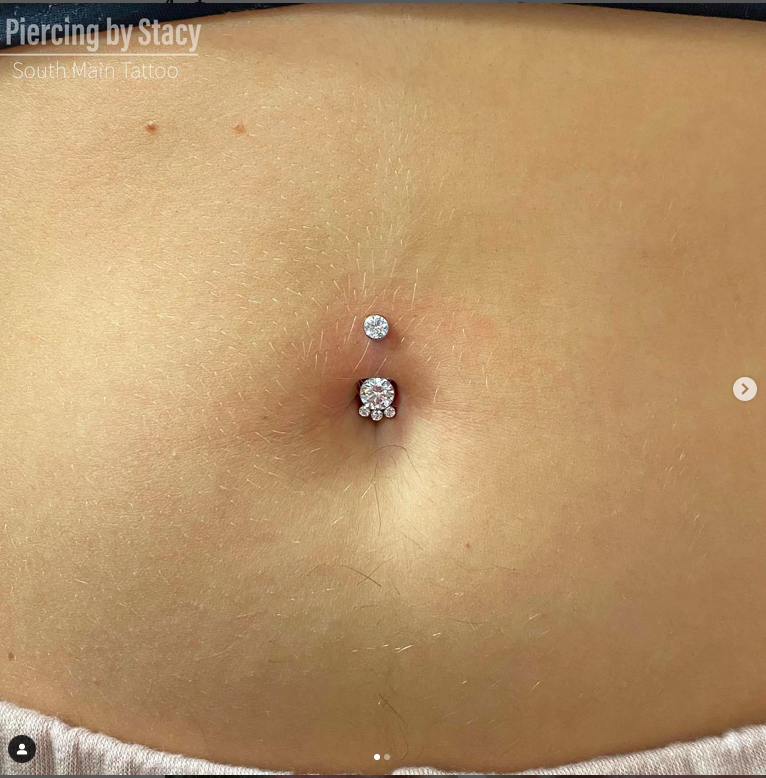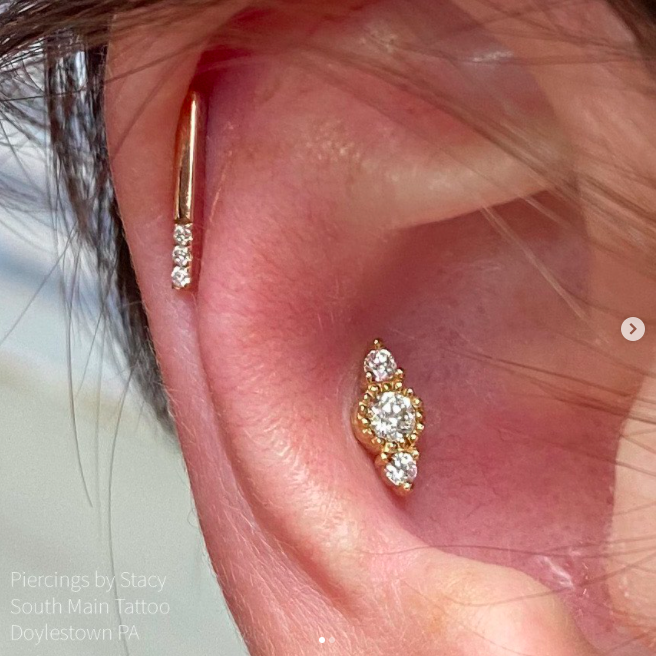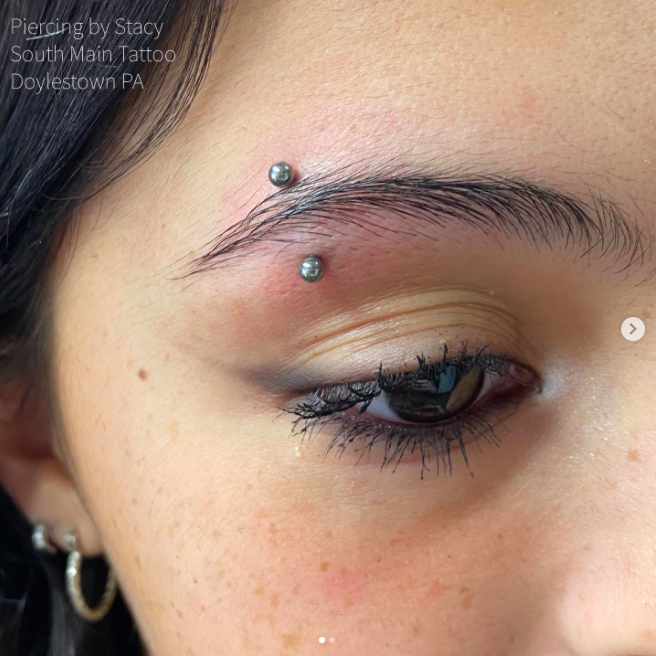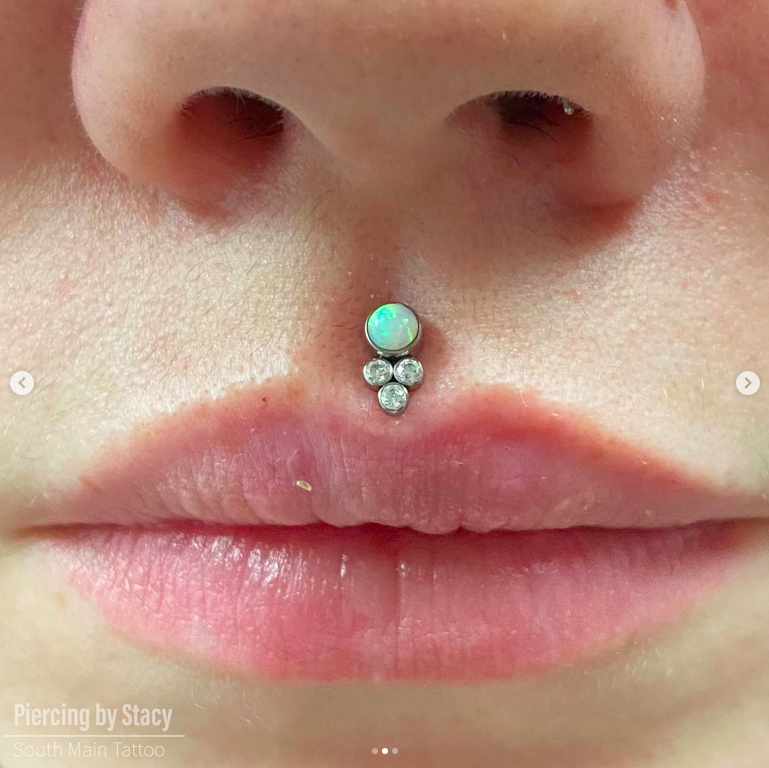Piercing
Our friendly & knowledgable piercers are there for you from day 1 through the entire healing process. We are here to answer questions and give advice on piercing care and will help you choose from our abundant variety of beautiful body jewelry! All of our body jewelry is internally threaded and threadless implant grade titanium or nickel free 14 kt solid gold. We carry jewelry from industry leaders such as Neometal, Anatometal, Leroi and Body Gems. We have an anodizer on site to make titanium jewelry any color you want, except black, free of charge!
We do offer ear piercings on children starting at age 7. Please click HERE for important info. And please see our policies for all piercings on minors in the “Policies” tab.
SUGGESTED AFTERCARE FOR BODY PIERCINGS
CLEANING SOLUTIONS
Packaged sterile saline is a gentle choice for piercing aftercare. Mixing your own sea salt solution is no longer a suggested practice from the APP. We strongly encourage you to use a sterile saline labeled for use as a wound wash. Contact lens saline, eye drops, and other saline products should never be used on a body piercing. Your saline ingredients should list .09% sodium chloride as the only ingredient. Mixing your own sea salt solution will commonly result in the product being far too salty and strong, this can over dry the piercing and interfere with healing.
CLEANING INSTRUCTIONS FOR BODY PIERCINGS
WASH your hands thoroughly prior to cleaning or touching your piercing for any reason.
SALINE rinse as needed during healing. For certain placements it may be easier to apply using clean gauze saturated with saline solution. A brief rinse afterward will remove any residue.
If your piercer suggests using soap, gently lather around the piercing and rinse as needed. Avoid using harsh soaps, or soaps with dyes, fragrances, or triclosan.
RINSE thoroughly to remove all traces of the soap from the piercing. It is not necessary to rotate the jewelry through the piercing.
DRY by gently patting with clean, disposable paper products because cloth towels can harbor bacteria and snag on jewelry, causing injury.
WHAT IS NORMAL?
Initially: some bleeding, localized swelling, tenderness, or bruising.
During healing: some discoloration, itching, secretion of a whitish-yellow fluid (not pus) that will form some crust on the jewelry. The tissue may tighten around the jewelry as it heals.
Once healed: the jewelry may not move freely in the piercing; do not force it. If you fail to include cleaning your piercing as part of your daily hygiene routine, normal but smelly bodily secretions may accumulate.
A piercing may seem healed before the healing process is complete. This is because tissue heals from the outside in, and although it feels fine, the interior remains fragile. Be patient, and keep cleaning throughout the entire healing period.
Even healed piercings can shrink or close in minutes after having been there for years! This varies from person to person; if you like your piercing, keep jewelry in—do not leave it empty.
WHAT TO DO
Wash your hands prior to touching the piercing; leave it alone except when cleaning. During healing it is not necessary to rotate your jewelry
Exercise during healing is fine; listen to your body.
Make sure your bedding is washed and changed regularly. Wear clean, comfortable, breathable clothing that protects your piercing while you are sleeping.
Showers tend to be safer than taking baths, as bathtubs can harbor bacteria. If you bathe in a tub, clean it well before each use and rinse off your piercing when you get out.
WHAT TO AVOID
Avoid cleaning with alcohol, hydrogen peroxide, antibacterial soaps, iodine, or any harsh products, as these can damage cells. Also avoid ointments as they prevent necessary air circulation.
Avoid Bactine®, pierced ear care solutions, and other products containing Benzalkonium Chloride (BZK). These can be irritating and are not intended for long-term wound care.
Avoid over-cleaning. This can delay your healing and irritate your piercing. • Avoid undue trauma such as friction from clothing, excessive motion of the area, playing with the jewelry, and vigorous cleaning. These activities can cause the formation of unsightly and uncomfortable scar tissue, migration, prolonged healing, and other complications.
Avoid all oral contact, rough play, and contact with others’ bodily fluids on or near your piercing during healing.
Avoid stress and recreational drug use, including excessive caffeine, nicotine, and alcohol.
Avoid submerging the piercing in unhygienic bodies of water such as lakes, pools, hot tubs, etc. Or, protect your piercing using a waterproof wound sealant bandage. These are available at most drugstores and work best for nipple, navel, and surface piercing placements.
Avoid all beauty and personal care products on or around the piercing including cosmetics, lotions, and sprays, etc.
Don’t hang charms or any object from your jewelry until the piercing is fully healed. • Sleeping directly on a healing cartilage piercing can cause irritation, even causing shifts in the piercing’s angle. Placing a travel pillow, on top of your pillow, and then placing your ear in the opening can be helpful to avoid this
HINTS AND TIPS
JEWELRY
Unless there is a problem with the size, style, or material of the initial jewelry, leave it in the place for the entire healing period. See a qualified piercer to perform any jewelry change that becomes necessary during healing.
Contact your piercer for a non-metallic jewelry alternative if your metal jewelry must be temporarily removed (such as for a medical procedure).
Leave jewelry in at all times. Even healed piercings that you have had for years can shrink or close in minutes! If removed, reinsertion can be difficult or impossible. See the APP brochure Preparing for Medical and Dental Procedures for more information.
With clean hands or paper products, be sure to regularly check threaded and threadless ends on your jewelry for tightness.
Should you decide you no longer want the piercing, simply remove the jewelry (or have a professional piercer remove it) and continue cleaning the piercing until the hole closes. In most cases only a small mark should remain.
In the event an infection is suspected, quality jewelry or an inert alternative may be left in place to allow for drainage of the infection, if approved by your physician. On rare occasion, when the jewelry is removed, the surface cells close up, which can seal the infection inside the piercing channel and result in an abscess. Until an infection is cleared up, discuss with your physician if you should leave in quality jewelry or an appropriate substitute.
FOR PARTICULAR AREAS
NAVEL:
A hard, vented eye patch (sold at pharmacies) can be applied under tight clothing (such as nylon stockings) or secured using a length of elastic bandage around the body (to avoid irritation from adhesive). This can protect the area from restrictive clothing, excess irritation, and impact during physical activities such as contact sports.
EAR/EAR CARTILAGE AND FACIAL:
Use the t-shirt trick: Dress your pillow in a large, clean t-shirt and turn it nightly; one clean t-shirt provides four clean surfaces for sleeping.
Maintain cleanliness of telephones, headphones, eyeglasses, helmets, hats, and anything that contacts the pierced area.
Use caution when styling your hair and advise your stylist of a new or healing piercing.
NIPPLES:
The support of a tight cotton shirt or sports bra may provide protection and feel comfortable, especially for sleeping.
GENITAL:
Genital Piercings – especially Triangles, Prince Alberts, Ampallangs, and Apadravyas – can bleed freely for the first few days. Be prepared. Additional cleaning after urination is not necessary
Wash your hands before touching on (or near) a healing piercing.
In most cases you can engage in sexual activity as soon as you feel ready, but maintaining hygiene and avoiding trauma are vital; all sexual activities should be gentle during the healing period.
Use barriers such as condoms, dental dams, and waterproof bandages, etc. to avoid contact with your partners’ body fluids, even in long-term monogamous relationships.
Use clean, disposable barriers on sex toys.
Use a new container of water-based lubricant; do not use saliva.
After sex, an additional saline rinse is suggested.
SURFACE ANCHORS:
These piercings require maintenance during their entire lifetime because matter can build up underneath the threaded top causing the piercing to become irritated. Saline and/or shower rinses may be helpful with removing matter from underneath the threaded top.
Avoid putting makeup on these piercings even after healing.
Even with proper care, surface anchors may be less permanent than other body piercings.
ALTERNATIVE AFTERCARE
Aftercare is an evolving conversation in the progression of body piercing. Aftercare needs can differ from one region and climate to another and not all products are widely available, discuss your specific needs with your body piercer. If you choose to use soap on a healing piercing consider using a gentle soap free from harsh chemicals, dyes, and perfumes. The use of an antibacterial soap is not suggested as it may over-dry and irritate your piercing. If your piercer suggests the use of a soap fully rinse away product after use.
If sterile saline is not available in your region a sea salt solution mixture can be a viable alternative. Dissolve 1∕8 to 1⁄4 teaspoon (.75 to 1.42 grams) of non-iodized (iodine free), fine grain sea salt into one cup (8 oz. / 250ml) of warm distilled or bottled water. A stronger mixture is not better; salt solution that is too strong can irritate the piercing.
*Disclaimer: These guidelines are based on a combination of vast professional experience, common sense, research, and extensive clinical practice. This is not to be considered a substitute for medical advice from a doctor. If you suspect an infection, seek medical attention. Be aware that many doctors have not received specific training regarding piercing. Your local piercer may be able to refer you to a piercing-friendly medical professional. For more information, see the APP Brochure Troubleshooting For You and Your Healthcare Professional.
*Use of this brochure does not imply membership in the APP.
SUGGESTED AFTERCARE FOR ORAL PIERCINGS
CLEANING SOLUTIONS
Use any or all of the following solutions for inside the mouth:
Antimicrobial or antibacterial alcohol-free mouth rinse*
Plain clean water
Packaged sterile saline (with no additives, read the label) is a gentle choice for piercing aftercare. Saline for contact lenses should not be used as piercing aftercare. Wound wash saline is available as a spray at pharmacies throughout North America.
Sea salt mixture: Dissolve 1/8 to 1/4 teaspoon (.75 to 1.42 grams) of non-iodized (iodine-free) sea salt into one cup (8 oz / 250 ml) of warm distilled or bottled water. A stronger mixture is not better; a saline solution that is too strong can irritate the piercing.
(If you have high blood pressure or a heart condition, please check with your doctor before using a saline product as your primary cleaning solution.)
(Consult your piercer for current suggested products.)
CLEANING INSTRUCTIONS FOR INSIDE THE MOUTH
Rinse mouth as needed (4-5 times) daily with a cleaning solution for 30-60 seconds, after meals and at bedtime during the entire healing period. When you over clean, it may cause discoloration or irritation of your mouth and piercing.
CLEANING INSTRUCTIONS FOR THE EXTERIOR OF LABRET (CHEEK & LIP) PIERCINGS
WASH your hands thoroughly prior to cleaning or touching your piercing for any reason.
SALINE rinse as needed during healing. For certain placements it may be easier to apply using clean gauze saturated with saline solution. A brief rinse afterward will remove any residue.
If your piercer suggests using soap, gently lather around the piercing and rinse as needed. Avoid using harsh soaps, or soaps with dyes, fragrances, or triclosan.
RINSE thoroughly to remove all traces of the soap from the piercing. It is not necessary to rotate the jewelry through the piercing.
DRY by gently patting with clean, disposable paper products because cloth towels can harbor bacteria and snag on jewelry, causing injury.
WHAT TO DO TO HELP REDUCE SWELLING
Allow small pieces of ice to dissolve in the mouth.
Take an over the counter, non-steroidal anti-inflammatory such as ibuprofen or naproxen sodium according to package instructions.
Don’t speak or move your jewelry more than necessary.
Sleep with your head elevated above your heart during the first few nights.
WHAT IS NORMAL?
For the first three to five days: significant swelling, light bleeding, bruising, and/or tenderness.
After that: Some swelling, light secretion of a whitish yellow fluid (not pus).
A piercing may seem healed before the healing process is complete. This is because they heal from the outside in, and although it feels fine, the tissue remains fragile on the inside. Be patient, and keep cleaning throughout the entire healing period.
Even healed piercings can shrink or close in minutes after having been there for years! This varies from person to person; if you like your piercing, keep jewelry in-do not leave the hole empty.
TO MAINTAIN GOOD ORAL HYGIENE
Use a new soft-bristled toothbrush and store it in a clean area away from other toothbrushes.
Brush your teeth and use your chosen rinse (saline or mouthwash) after every meal.
During healing floss daily, and gently brush your teeth, tongue and jewelry. Once healed, brush the jewelry more thoroughly to avoid plaque build up.
TO STAY HEALTHY
The healthier your lifestyle, the easier it will be for your piercing to heal.
Get enough sleep and eat a nutritious diet.
ORAL PIERCING HINTS AND TIPS
JEWELRY
Once the swelling has subsided, it is vital to replace the original, longer jewelry with a shorter post to avoid intra-oral damage. Consult your piercer for their downsize policy.
Because this necessary jewelry change often occurs during healing, it should be done by a qualified piercer.
Contact your piercer for a non-metallic jewelry alternative if your metal jewelry must be temporarily removes (such as for a medical procedure).
Should you decide you no longer want the piercing, simply remove the jewelry (or have a professional piercer remove it) and continue cleaning the piercing until the hole closes. In most cases only a small mark will remain.
In the even an infection is suspected, quality jewelry or an inert alternative should be left in place to allow for drainage or the infection. Should the jewelry be removed, the surface cells can close up sealing the infection inside the piercing channel, resulting in an abscess. Until an infection is cleared up, the the jewelry in!
EATING
Slowly eat small bites of food.
Avoid eating spicy, salty, acidic, or hot temperature foods or beverages for a few days.
Cold foods and beverages are soothing and help reduce swelling.
Foods like mashed potatoes and oatmeal are hard to eat because they stick to your mouth and jewelry.
For tongue piercing, try to keep your tongue level in your mouth as you eat because the jewelry can get between your teeth when your tongue turns.
For labret (cheek and lip) piercings: be cautious about opening your mouth too wide as this can result in the jewelry catching on your teeth.
Each body is unique and healing times vary considerably. If you have any questions, please contact your piercer.
WHAT TO AVOID
Do not play with your jewelry. Long term effects include permanent damage to teeth, gums, and other oral structures. See the APP’s Brochure: Oral Piercing Risks and Safety Measures for more information.
Avoid undue trauma; excessive talking or playing with the jewelry during healing can cause the formation of unsightly and uncomfortable scar tissue, migration, and other complications.
Avoid using mouthwash containing alcohol. It can irritate the piercing and delay healing.
Avoid oral sexual contact including French (wet) kissing or oral sex during healing (even with a long-term partner).
Avoid chewing gum, tobacco, fingernails, pencils, sunglasses, etc.
Avoid sharing plates, cups, and eating utensils.
Avoid smoking! It increases risks and lengthens healing time.
Avoid stress and all recreational drug use.
Avoid aspirin, alcohol, and large amounts of caffeine as long as you are experiencing bleeding or swelling.
Avoid submerging healing piercings in bodies of water such as lakes, pools, etc.Each body is unique and healing times vary considerably. If you have any questions, please contact your piercer.
* DISCLAIMER:
These guidelines are based on a combination of vast professional experience, common sense, research and extensive clinical practice. This is not to be considered a substitute for medical advice from a doctor. If you suspect an infection, seek medical attention. Be aware that many doctors have not received specific training regarding piercing. Your local piercer may be able to refer you to a piercing-friendly medical professional. For more information, see the APP Brochure Troubleshooting For You and Your Healthcare Professional.
*Use of this brochure does not imply membership in the APP.






